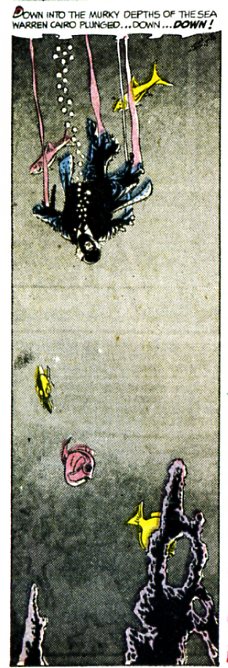This review first ran at The Comics Journal.
______________________
Steve Ditko
Strange Suspense: The Steve Ditko Archives volume 1
Fantagraphics
This is a collection of comics great Steve Ditko’s first published stories, mostly pulp horror from the early 1950s. I found it literally unreadable.
Usually when I write a review, I try to put in an honest effort to actually read every word. I gave it a go here and…well, this is what I found myself trudging through in the second story in the volume, “Paper Romance.”
It was too late for me to back down now! So I wrote the letter as soon as I got home. A letter that had been in my mind for years…telling everything about myself and hinting at what I was looking for in a man…the rest was to come if and when somebody answered my letter! The next few days dragged by with leaden feet and after a while I forgot completely about my letter…well not completely! But then…
Did you read that whole thing? If you did and you enjoyed it, you’re a hardier soul than I. “I got my letter and then I thought about my letter and then I thought about my letter some more and then I used a metaphor: ‘leaden feet’!” That’s just dreadful. And, yes, that’s the one romance story in the book, but the horror and adventure comics are not appreciably better; there’s still the numbing repetition, the tin ear, and the infuriating refusal to finesse said tin ear by leaving the damn pictures alone to tell their own story.
Whether this is Ditko’s fault entirely is unclear. Fantagraphics doesn’t give writer’s credits for the volume, which may mean that Ditko wrote the stories himself or, alternately, that the scripters are anonymous. Even if I don’t know who to blame, though, I sure as hell am blaming somebody for the fact that when the goblins surround Avery, we have text telling us “They decided it was time to surround Avery” so that Ditko has to squeeze the actual picture of the goblins surrounding Avery into an even smaller space. And even when the text boxes fall silent, we have the endless nattering of the dialogue balloons. If the haunted sailor says he hears a wild laugh once, he’s got to say it five times. It’s like having your tale of suspense shouted at you by your elderly deaf uncle . Who is stupid.
Even putting aside the writing, in terms of visual flow and storytelling, Ditko, at least at this point in his career, varies between mediocre and downright bad. He’s got some entertainingly loopy ideas, but he’s constantly burying his punchlines — in his riff on Cinderella, for example, the final panel is supposed to show you the good prince changing into a vampire and the three sisters with their legs ripped off so they fit the slippers. But it’s done so small I had to stare at it for a good 15 seconds before I could make head or tail of it, and then all I could think was — why do you need to pull a leg off to fit into a shoe? Wouldn’t you want to cut the foot instead?
But the solution to all of these problems is easy. Just sell your soul to the devil for the power to create an invulnerable super-worm with poison lipstick who will tear out your uncle’s eyes and replace them with wax. Or something like that. I’m not really sure of the exact plot ins and outs, because I just skimmed the whole damn thing, thank you very much, which was a much, much more pleasurable experience than reading those first couple of stories. Because, whatever Ditko’s limitations, even at this early stage in his career, he’s a fascinating artist with a bizarre and entirely idiosyncratic visual imagination. Eerily writhing smoke, expressive hands twisted into unlikely or even impossible positions, angled shots from up in the skylight — none of this will surprise anyone familiar with Ditko’s work, but it’s all as tasty as ever. In this volume I noticed especially his faces. Everyone in Ditko has these strong lined physiognomies that hover on the verge of caricature. The result in these horror titles is that humans and monsters aren’t so much opposed as they are on a continuum of potential deformity. Even Ditko’s hot dames have features which are too heavy, too malleable — they look like female impersonators, or like they’re wearing masks.
My favorite image in the book wasn’t typical Ditko at all, though. Instead it was this.
Usually Ditko’s drawings are crowded, even cluttered. This panel, though, uses negative space like a Japanese print. It’s an intriguing reminder that, along with the inevitable stumbles, apprentice work can also result in the occasional uncharacteristic, and surprisingly graceful, experiment.



